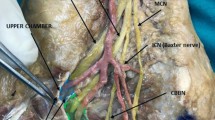Abstract
Background
The aim of this study was to demonstrate anatomical features of the anterior tarsal tunnel and the deep peroneal nerve and to discuss the importance of these structures for the anterior tarsal tunnel syndrome and some other surgical approaches to minimize the injury risk.
Methods
Lower limbs of 18 formalin fixed cadavers were examined. The limbs showed no evidence of pathology or trauma.
Results
The lateral length of the tunnel was 21.7 ± 4.3 mm and the medial length of the tunnel was 55.0 ± 9.0 mm. The width of the tunnel at the inferior border between the extensor hallucis longus and extensor digitorum longus tendons was 12.6 ± 2.1 mm. The location of the deep peroneal nerve bifurcation was in the anterior tarsal tunnel in 31 specimens (86.1%) and distal to the tunnel in two specimens (5.6%). In three specimens (8.3%) there was no bifurcation because of the absence of the medial terminal branch of the deep peroneal nerve. In these three specimens, the superficial peroneal nerve distributed to the adjacent sides of the great and second toes. Bifurcation above the tunnel was not observed in our specimens. There was connection between the deep peroneal nerve and the superficial peroneal nerve in 10 specimens (27.8%) in the first interdigital space. During the observations, the presence of a fibrous band over the nerve and vessel was noted in 22 specimens (61.1%).
Conclusions
We believe that a detailed anatomic knowledge of the anterior tarsal tunnel and the deep peroneal nerve will be of help during surgical approaches to this area and the diagnosis of the problems related to the peripheral nerves on the dorsum of the foot.





Similar content being viewed by others
References
Akyuz G, Us O, Turan B, Kayhan O, Canbulat N, Yilmar IT (2000) Anterior tarsal tunnel syndrome. Electromyogr Clin Neurophysiol 40:123–128
Andresen BL, Wertsch JJ, Stewart WA (1992) Anterior tarsal tunnel syndrome. Arch Phys Med Rehabil 73:1112–7
Buckingham RA, Winson IG, Kelly AJ (1997) An anatomical study of a new portal for ankle arthroscopy. J Bone Joint Surg 79B(4):650–652
Buyukmumcu M, Ustun ME, Seker M, Kocaogullari Y, Sagmanligil A (1999) The possibility of deep peroneal nerve neurotisation by the superficial peroneal nerve: an anatomical approach. J Anat 194:309–312
Dellon AL (1990) Deep peroneal nerve entrapment on the dorsum of the foot. Foot Ankle Int 11(2):73–80
Gessini L, Jandolo B, Pietrangeli A (1984) The anterior tarsal syndrome. Report of four cases. J Bone Joint Surg 66A(5):786–787
Kopell HP, Thompson WAL (1963) Peripheral entrapment neuropathies. Williams and Wilkins, Baltimore, pp. 35–37
Lawrence SJ, Botte MJ (1995) The deep peroneal nerve in the foot and ankle: an anatomic study. Foot Ankle Int 16(11):724–728
Rab M, Ebmer J, Dellon AL (2001) Innervation of the sinus tarsi and implications for treating anterolateral ankle pain. Ann Plast Surg 47(5):500–504
Reed SC, Wright S (1995) Compression of the deep branch of the peroneal nerve by the extensor hallucis brevis muscle: a variation of the anterior tarsal tunnel syndrome. Can J Surg 38(6):545–546
Saito A, Kikuchi S (1998) Anatomic relations between ankle arthroscopic portal sites and the superficial peroneal and saphenous nerves. Foot Ankle Int 19(11):748–752
Standring S (ed) (2005) Gray’s anatomy. 39th edn. Churchill Livingstone, Spain, p. 1505
Takao M, Uchio Y, Shu N, Ochi M (1998) Anatomic bases of ankle arthroscopy: study of superficial and deep peroneal nerves around anterolateral and anterocentral approach. Surg Radiol Anat 20:317–320
Zongzhao L, Jiansheng Z, Li Z (1991) Anterior tarsal tunnel syndrome. J Bone Joint Surg 73B(3):470–473
Author information
Authors and Affiliations
Corresponding author
Additional information
This study was presented on the 4th Asian-Pacific International Congress of Anatomists (APICA 2005) in Kusadasi, Turkey on 7-10 September 2005.
Rights and permissions
About this article
Cite this article
Aktan Ikiz, Z.A., Ucerler, H. & Uygur, M. Dimensions of the anterior tarsal tunnel and features of the deep peroneal nerve in relation to clinical application. Surg Radiol Anat 29, 527–530 (2007). https://doi.org/10.1007/s00276-007-0229-x
Received:
Accepted:
Published:
Issue Date:
DOI: https://doi.org/10.1007/s00276-007-0229-x




